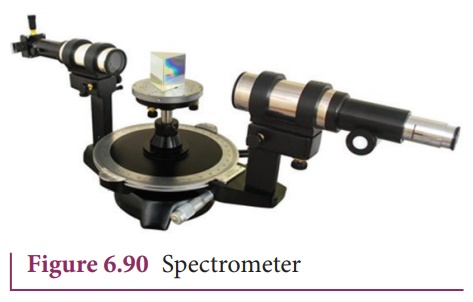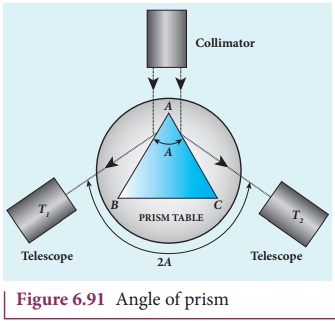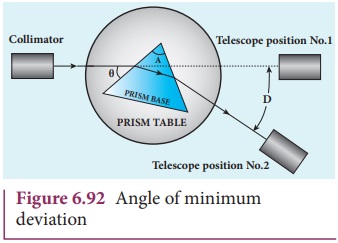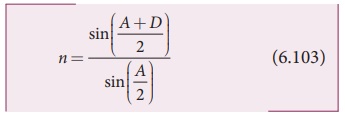Optical Instruments - Spectrometer | 12th Physics : UNIT 7 : Wave Optics
Chapter: 12th Physics : UNIT 7 : Wave Optics
Spectrometer
Spectrometer
The spectrometer is an optical
instrument used to study the spectra of different sources of light and to
measure the refractive indices of materials. It is shown in Figure 6.90. It
consists of basically three parts. They are (i) collimator (ii) prism table and
(iii) Telescope.

(i) Collimator
The collimator is an arrangement to
produce a parallel beam of light. It consists of a long cylindrical tube with a
convex lens at the inner end and a vertical slit at the outer end of the tube.
The distance between the slit and the lens can be adjusted such that the slit
is at the focus of the lens. The slit is kept facing the source of light. The
width of the slit can be adjusted. The collimator is rigidly fixed to the base
of the instrument.
(ii) Prism table
The prism table is used for mounting
the prism, grating etc. It consists of two circular metal discs provided with
three levelling screws. It can be rotated about a vertical axis passing through
its centre and its position can be read with verniers V1 and V2
. The prism table can be raised or lowered and can be fixed at any desired
height.
(iii) Telescope
The telescope is an astronomical
type. It consists of an eyepiece provided with cross wires at one end and an objective
lens at its other end. The distance between the objective lens and the eyepiece
can be adjusted so that the telescope forms a clear image at the cross wires,
when a parallel beam from the collimator is incident on it.
The telescope is attached to an arm
which is capable of rotation about the same vertical axis as the prism table. A
circular scale graduated in half degree is attached to it. Both the telescope
and prism table are provided with radial screws for fixing them in a desired
position and tangential screws for fine adjustments.
Adjustments of the spectrometer
The following adjustments must be
made before doing the experiment using spectrometer.
(a) Adjustment of the eyepiece The telescope is turned towards an illuminated surface and the
eyepiece is moved to and fro until the cross wires are clearly seen.
(b) Adjustment of the telescope
The telescope is adjusted to receive parallel rays by turning it
towards a distant object and adjusting the distance between the objective lens
and the eyepiece to get a clear image on the cross wire.
(c) Adjustment of the collimator
The telescope is brought along the axial line with the
collimator. The slit of the collimator is illuminated by a source of light. The
distance between the slit and the lens of the collimator is adjusted until a
clear image of the slit is seen at the cross wire of the telescope. Since the
telescope is already adjusted for parallel rays, a well-defined image of the
slit can be formed, only when the light rays emerging from the collimator are
parallel.
(d) Levelling the prism table The prism table is adjusted or levelled to be in horizontal
position by means of levelling screws and a spirit level.
Determination of refractive index of material of the prism
The preliminary adjustments of the
telescope, collimator and the prism table of the spectrometer are made. The
refractive index of the prism can be determined by knowing the angle of the
prism and the angle of minimum deviation.
(i) Angle of the prism (A)

The prism is placed on the prism
table with its refracting edge facing the collimator as shownin Figure 6.91.
Theslitis illuminated by a sodium light (monochromotic light). The parallel
rays coming from the collimator fall on the two faces AB and AC. The telescope
is rotated to the position T1
until the image of the slit formed by the reflection at the face AB is made to coincide with the vertical
cross wire of the telescope. The readings of the verniers are noted. The
telescope is then rotated to the position T2
where the image of the slit formed by the reflection at the face AC coincides withthe vertical cross
wire. The readings are again noted.
The difference between these two
readings gives the angle rotated by the telescope, which is twice the angle of
the prism. Half of this value gives the angle of the prism A.
(ii) Angle of minimum deviation (D)
The prism is placed on the prism
table so that the light from the collimator falls on a refracting face, and the
refracted image is observed through the telescope as shown in Figure 6.92. The
prism table is now rotated so that the angle of deviation decreases. A stage
comes when the image stops for a moment and if we rotate the prism table
further in the same direction, the image is seen to recede and the angle of
deviation increases. The vertical cross wire of the telescope is made to
coincide with the image of the slit where it turns back. This gives the minimum
deviation position.

The readings of the verniers are
noted. Now, the prism is removed and the telescope is turned to receive the
direct ray and the vertical cross wire is made to coincide with the image. The
readings of the verniers are noted. The difference between the two readings
gives the angle of minimum deviation D.
The refractive index of the material of the prism n is calculated using the formula,

The refractive index of a liquid may
be determined in the same way using a hollow glass prism filled with the given
liquid. Spectrometer experiments are discussed in the Practicals given in
Volume 1 of this book.
Related Topics